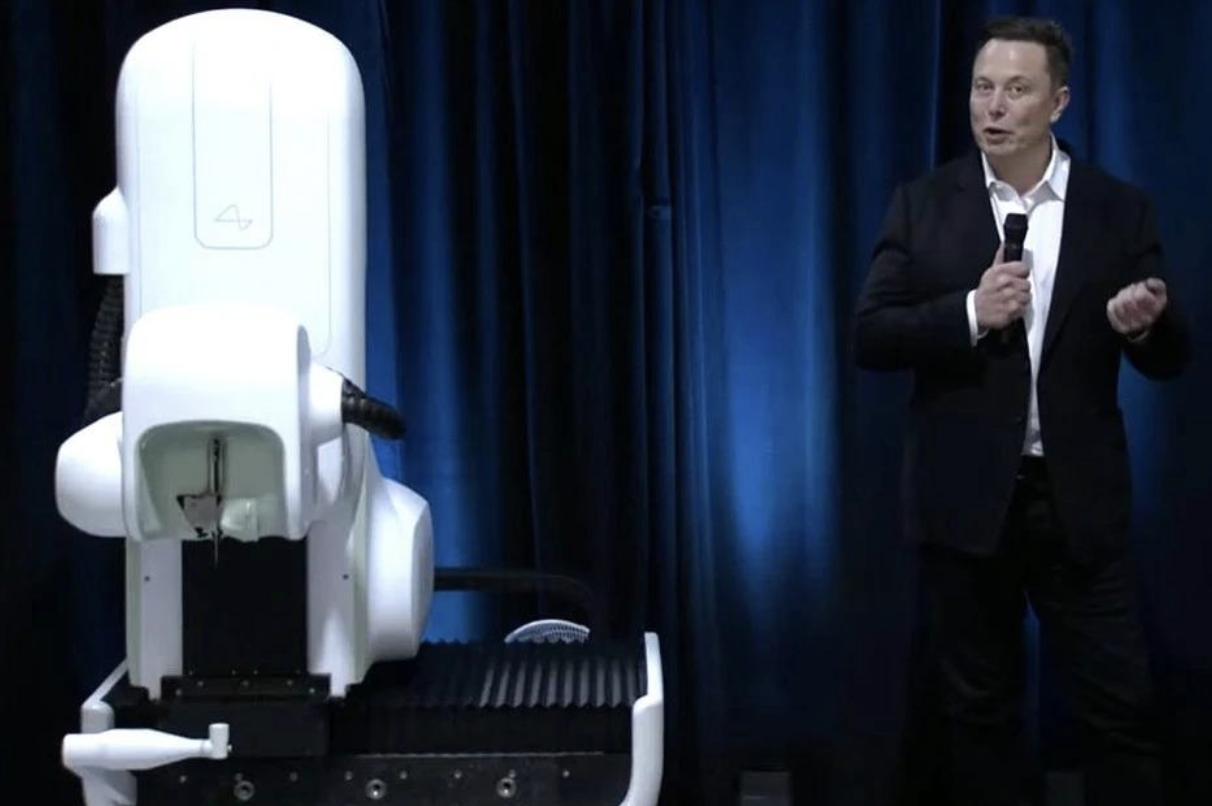Regular payments function is available
Elon Musk is initiating the implantation of chips into the human brain: Through the power of thought, individuals will acquire the ability to communicate and conquer incurable diseases.
The technology billionaire’s company is commencing 6-year trials with volunteers for a system that will assist paralyzed individuals in communicating with the outside world.

Elon Musk and Surgical Robot of the Neuralink Project
After conducting experiments on pigs and monkeys, Neuralink, a company associated with Elon Musk, has been granted permission to proceed with testing brain implants in humans. In the official blog of the company focused on developing a “brain-computer” interface, an announcement was posted about seeking participants for a 6-year study. Neuralink is inviting individuals with quadriplegia due to spinal cord injuries or amyotrophic lateral sclerosis (ALS), the same disease Stephen Hawking had, to join the experiment.
Neurophysiologists aren’t promising a cure to paralyzed patients, but they hope that in the initial stages of the research, patients will learn to control a computer mouse and keyboard through the power of thought. This breakthrough offers an incredible opportunity for those who are completely dependent on others for communication with the outside world.
How does it work?
The N1 brain implant, roughly the size of a coin, collects data on brain electrical activity. It does this through 64 threads, each equipped with a total of 1024 electrodes, ensuring a strong electronic connection with the brain. The surgical procedure involves a specialized robotic surgeon inserting electrode threads into the brain’s motor control area through a small opening in the skull. When electrodes are positioned near neurons, they capture brain signals and transmit them wirelessly to a specialized application. Artificial intelligence algorithms decode these signals and determine the intended movements of the individual. Initially, neurophysiologists aim to teach paralyzed individuals the simplest task: typing text on a computer screen. But in the future, this technology can bring back to their feet patients who have lost the ability to walk as a result of injuries to the spine and spinal cord. Through the “brain-computer” interface, it is possible to bypass the damaged area and send commands directly to the motor neurons of the spinal cord. Electrical stimuli will awaken the “stepping” neurons, allowing the person to walk independently!
Is Musk’s vision all-powerful, because it seems to be true?
In previous Neuralink experiments, even monkeys were able to cope with the task of moving the cursor with the power of thought. A couple of years ago, Elon Musk posted a video featuring a monkey with a brain implant enthusiastically playing ping pong on a computer screen. For each successful hit with the “racket,” the monkey received a tasty reward in the form of banana smoothie. Interestingly, similar tricks had been performed by animals even before Musk’s experiments. Back in 2012, a team from the University of Pittsburgh Medical Center in the USA astounded the public with a different video. It showcased a fully paralyzed 36-year-old woman feeding herself chocolate by controlling a robotic arm with her thoughts.
Additionally, numerous teams worldwide are working on brain implants. Why do we follow Elon Musk’s experiments with bated breath? Is there anything extraordinary beyond excellent PR? According to Professor Alexander Kaplan, head of the Laboratory of Neurophysiology and Neurointerfaces at the Biological Faculty of Moscow State University, Neuralink has achieved two revolutionary breakthroughs. In Elon Musk’s electrode system, the number of contacts reaches up to 100,000, which is several orders of magnitude greater than any other system. Consequently, no other company has such a volume of channels for “connecting the brain,” or more precisely, for inputting or outputting electrical signals from neurons.
The second outstanding innovation is the creation of an automated surgical system for implanting ultra-flexible threads of the implant into the brain—each of these threads is four times thinner than a human hair. Scientists compare the emergence of this surgical robot to the invention of the sewing machine, which once revolutionized clothing production. The automated system, PRIME (short for Precise Robotically Implanted Brain-Computer Interface), turns complex surgical procedures into routine operations, taking no more than an hour. The precision surgical robot, often likened to a “sewing machine,” deftly inserts threads equipped with electrodes into brain tissue, all without causing harm to blood vessels or nerve cells. This surgical procedure is bloodless, eliminates the need for general anesthesia, and allows patients to return home on the same day.
But what lies beyond the horizon?
The potential of this technology is vast. A brain implant can achieve more than simply issuing commands like “Stand up and walk!” For example, today in the world about 150 thousand patients with epilepsy have gotten rid of their illness thanks to corrective electrodes implanted into the brain. Algorithms, by analyzing brain electrical signals, can detect the onset of an epileptic seizure and suppress it with a small electrical impulse. A new type of brain implant will be able to stimulate certain areas of the brain to fight Parkinson’s disease, depression, severe mental disorders and even eating disorders – in other words, gluttony.
But this bright future is not just around the corner. Even with successful clinical trials, the widespread use of Musk’s brain implants may not happen for another 10 years or so. However, Neurаlink specialists have a fair share of challenges ahead. The main concern, according to Professor Kaplan, is the issue of biocompatibility. The body will perceive the implant as foreign and attempt to isolate it by encapsulating it with connective tissue. To keep the chip functioning, it will need to be extracted every 2-5 years. In addition, animal experiments have shown that the procedure does not provide a 100% guarantee of safety. Nevertheless, human trials will provide a significant boost to the entire brain-computer interface industry. It’s not necessarily guaranteed that Elon Musk’s startup will emerge as the winner in this race.


